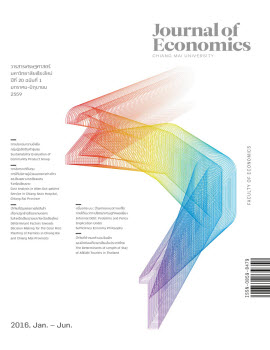ปัจจัยที่มีผลต่อการตัดสินใจเลือกปลูกข้าวสีของเกษตรกร ในจังหวัดเชียงรายและจังหวัดเชียงใหม่ Determinant Factors towards Decision Making for the Color Rice Planting of Farmers in Chiang Rai and Chiang Mai Provinces
Keywords:
ข้าวสี, พันธุ์ข้าว, การปลูกข้าว, แบบจำลองมัลติโนเมียลโลจิต, เชียงใหม่, เชียงราย, Colored-rice, Rice Varieties, Rice Implantation, Multinomial Logit, Chiang Mai, Chiang RaiAbstract
งานวิจัยนี้มีวัตถุประสงค์เพื่อศึกษาปัจจัยที่ทำให้เกษตรกรเลือกปลูกข้าวสี 3 พันธุ์ ได้แก่ ข้าวหอมมะลิแดง ไรซ์เบอร์รี่ และก่ำล้านนา(เหนียวดำ) ของเกษตรกรจังหวัดเชียงรายและเชียงใหม่ โดยใช้การเก็บแบบสอบถามจากเกษตรกรผู้ปลูกข้าวสีในจังหวัดเชียงรายและเชียงใหม่ จำนวน 320 ตัวอย่าง ด้วยแบบจำลอง Multinomial Logit และ
กำหนดให้ข้าวพันธุ์หอมนิลเป็นกรณีพื้นฐานผลการศึกษาพบว่าปัจจัยที่กำหนดการเลือกพันธุ์ข้าวทั้ง 3 พันธุ์อย่างมีนัยสำคัญทางสถิติ คือ การเข้าร่วมกลุ่มของเกษตรกร วัตถุประสงค์ผลิตเพื่อบริโภคแล้วจริงขาย สำหรับต้นทุนการเพาะปลูก (นาปรัง) การมีมาตรฐานรับรองการผลิต เป็นปัจจัยที่กำหนดการเลือกปลูกข้าวไรซ์เบอร์รี่และก่ำล้านนา ส่วนประสบการณ์ในการปลูกข้าวสี และการผลิตแบบมีพันธะสัญญานั้นมีผลต่อการเลือกปลูกข้าวหอมมะลิแดงและก่ำล้านนา นอกจากนี้ยังพบว่าขนาดของพื้นที่ปลูกมีผลต่อการปลูกข้าวหอมมะลิแดงและไรซ์เบอร์รี่ การศึกษายังพบว่าปัจจัยรายได้จากการเพาะปลูก(นาปี) ยังมีผลต่อการเลือกปลูกข้าวหอมมะลิแดง ปัจจัยด้านราคาข้าวเปลือกแห้งมีผลต่อการเลือกปลูกข้าวไรซ์เบอร์รี่ และพื้นที่ราบลุ่มมีผลต่อการเลือกปลูกข้าวก่ำล้านนาด้วย ดังนั้นนโยบายที่จะจูงใจให้เกษตรกรเลือกปลูกข้าวสีมากขึ้นได้แก่ การให้ความรู้แก่เกษตรกร การส่งเสริมให้เกษตรกรปลูกข้าวสีแบบมีพันธะสัญญาและราคารับซื้อที่เป็นธรรม รวมถึงการส่งเสริมให้เกษตรกรผู้ผลิตข้าวสีได้รับการรับรองมาตรฐานทางด้านการผลิตต่างๆ เช่น มาตรฐานเกษตรที่ดีและเหมาะสม มาตรฐานเกษตรอินทรีย์ เป็นต้น
The objective of this study was to identify determinant factors of farmer’s choosing for colored rice planting for three types; Red jasmine rice, Rice berry and black sticky rice (Hom Nin) in Chiangrai and Chiangmai provinces. 320 questionnaires were collected from those farmers who planted colored rice in these two provinces. Multinomial logistic regression was employed for data analysis by assigning black sticky rice (Hom Nin) as a based category. The study found that the significant determinant factors choosing three colored rice plantation included their participation with farmer group, planting for their own consumption and selling the left over, cost for dry season rice plantation, having standard of production, these factors determined for Rice Berry and Black sticky rice (Hom Nin) plantation. While experience of colored rice plantation and production based contract were determinant factors towards Red Jasmine rice and Black sticky rice plantation. In addition, size of production was a determinant factor towards red jasmine rice and Rice Berry plantation. Moreover, Income from in season rice plantation was a determinant factor toward red jasmine rice plantation. While cost of paddy was a determinant factor towards Rice Berry plantation. Black sticky rice (Hom Nin) plantation was determined by having low land geography for plantation. In terms of policy recommendations, in order to draw an attention from farmer choosing colored rice plantation were providing colored rice plantation knowledge, supporting and promoting plantation based contract and having a reasonable selling price and promoting standard of production such as standard of farmer’s good practices, using bio-agriculture standard for plantation.
Published
Issue
Section
License
All opinions and contents in the CMJE are the responsibility of the author(s). Chiang Mai University Journal of Economics reserves the copyright for all published materials. Papers may not be reproduced in any form without the written permission from Chiang Mai University Journal of Economics.
ข้อคิดเห็นที่ปรากฏและแสดงในเนื้อหาบทความต่างๆในวารสารเศรษฐศาสตร์มหาวิทยาลัยเชียงใหม่ ถือเป็นความเห็นและความรับผิดชอบโดยตรงของผู้เขียนบทความนั้นๆ มิใช่เป็นความเห็นและความรับผิดชอบใดๆของวารสารเศรษฐศาสตร์ มหาวิทยาลัยเชียงใหม่
บทความ เนื้อหา และข้อมูล ฯลฯ ในวารสารเศรษฐศาสตร์มหาวิทยาลัยเชียงใหม่ ถือเป็นลิขสิทธิ์เฉพาะของคณะเศรษฐศาสตร์มหาวิทยาลัยเชียงใหม่ หากบุคคลหรือหน่วยงานใดต้องการนำทั้งหมดหรือส่วนหนึ่งส่วนใดไปเผยแพร่ต่อหรือเพื่อกระทำการใดๆ จะต้องได้รับอนุญาตเป็นลายลักษณ์อักษร จากวารสารเศรษฐศาสตร์ มหาวิทยาลัยเชียงใหม่





